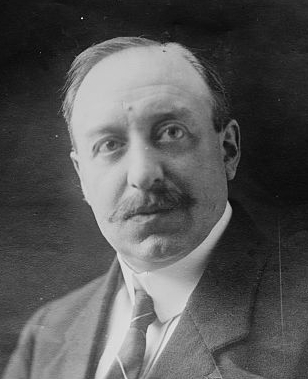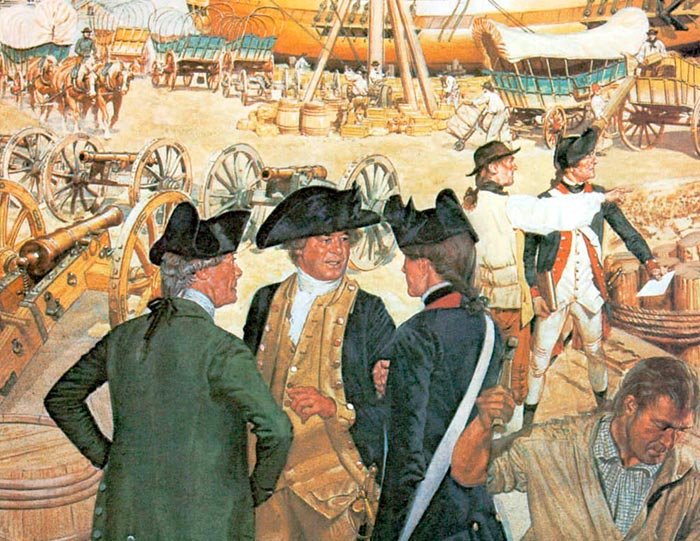|
David L. Stone
David Lamme Stone Jr. (15 August 1876 – 28 December 1959) was a United States Army major general. As a junior officer in 1917, he supervised the creation of Camp Lewis in Washington state. As a general officer in 1936, he returned there to command the 3rd Infantry Division. He held several other commands until retiring in 1940. Early life and education Stone was born in Stoneville, Mississippi. His parents both died when he was young, so he was raised by an aunt and uncle in nearby Greenville, Mississippi. Stone entered the United States Military Academy in June 1894. He graduated last in a class of 59 cadets in April 1898 and was commissioned as an infantry officer. Military career Soon after graduation, Stone was sent to Cuba with the 22nd Infantry during the Spanish–American War. His regiment returned to Fort Crook in Nebraska and then was ordered to the Philippines in January 1899. He served in combat in the Philippines until the end of 1901. Stone returned to the Uni ... [...More Info...] [...Related Items...] OR: [Wikipedia] [Google] [Baidu] |
Stoneville, Mississippi
Stoneville is a census-designated place and unincorporated community located in northeastern Washington County, Mississippi. Deer Creek flows through Stoneville. A post office was established in 1876, and remains open. Stoneville was incorporated in 1882, though it is no longer incorporated. Stoneville was a stop on the Yazoo and Mississippi Valley Railroad, established in the 1880s, and a stop on the Columbus and Greenville Railway, established in the 1920s. The Jamie Whitten Delta States Research Center is located in Stoneville. George B. Vogt was a notable entomologist there. It was first named as a CDP in the 2020 Census which listed a population of 39. Demographics 2020 census ''Note: the US Census treats Hispanic/Latino as an ethnic category. This table excludes Latinos from the racial categories and assigns them to a separate category. Hispanics/Latinos can be of any race.'' Notable people * Johnny "Big Moose" Walker Johnny "Big Moose" Walker (June 27, 1927 ... [...More Info...] [...Related Items...] OR: [Wikipedia] [Google] [Baidu] |
Greenville, Mississippi
Greenville is a city in and the county seat of Washington County, Mississippi, United States. The population was 34,400 at the 2010 census. It is located in the area of historic cotton plantations and culture known as the Mississippi Delta. History Early history This area was occupied by indigenous peoples for thousands of years. When the French explored here, they encountered the historic Natchez people. As part of their colony known as ''La Louisiane'', the French established a settlement at what became Natchez, Mississippi. Other Native American tribes also lived in what is now known as Mississippi. The current city of Greenville is the third in the State to bear the name. The first, (known as Old Greenville) located to the south near Natchez, became defunct soon after the American Revolution, as European-American settlement was then still concentrated in the eastern states. The second Greenville was founded in 1824 by American William W. Blanton, who filed for land from ... [...More Info...] [...Related Items...] OR: [Wikipedia] [Google] [Baidu] |
United States Department Of War
The United States Department of War, also called the War Department (and occasionally War Office in the early years), was the United States Cabinet department originally responsible for the operation and maintenance of the United States Army, also bearing responsibility for naval affairs until the establishment of the Navy Department in 1798, and for most land-based air forces until the creation of the Department of the Air Force on September 18, 1947. The Secretary of War, a civilian with such responsibilities as finance and purchases and a minor role in directing military affairs, headed the War Department throughout its existence. The War Department existed from August 7, 1789 until September 18, 1947, when it split into the Department of the Army and the Department of the Air Force. The Department of the Army and Department of the Air Force later joined the Department of the Navy under the United States Department of Defense in 1949. History 18th century The Departme ... [...More Info...] [...Related Items...] OR: [Wikipedia] [Google] [Baidu] |
Chief Of The United States Army Reserve
The chief of the United States Army Reserve (CAR) is the commanding officer of the United States Army Reserve, the reserve component of the United States Army. As the highest-ranking officer in the United States Army Reserve, the CAR is the principal advisor to the chief of staff of the Army on all matters relating to the Army Reserve, and is responsible for the personnel, operations and construction budgets of the Army Reserve, subject to the supervision and control of the secretary of the Army. - Office of Army Reserve: appointment of Chief. Dual-hatted as Commanding General, United States Army Reserve Command, the CAR is also responsible to the Commanding General, United States Army Forces Command for the oversight of operationally-deployed Army Reserve forces. By statute, the CAR is a member of the Army Staff, as well as one of five Army Reserve members of the Reserve Forces Policy Board. The CAR is also designated by statute as the executive agent for the Full Time Sup ... [...More Info...] [...Related Items...] OR: [Wikipedia] [Google] [Baidu] |
Seventh Corps Area
The Seventh Corps Area was a Corps area, effectively a military district, of the United States Army active from 1920 to 1941. It initially was responsible for army forces in Kansas, Minnesota, Missouri (but not Jefferson Barracks), North Dakota, South Dakota, Iowa and Nebraska. Army responsibility for Arkansas was transferred from the Fourth Corps Area to the Seventh Corps Area on 1 December 1920. In October 1940, the War Department implemented a transfer of tactical command functions of the Corps areas, moving tactical forces to field armies and transforming the Corps areas to Service Commands, themselves part of Army Service Forces. The Seventh Corps Area maintained its name until May 1941, when it was officially designated HQ, Seventh Corps Area Service Command (HQ, Seventh CASC) in May 1941. While the Seventh Corps Area no longer existed, the HQ, Seventh CASClater re-designated HQ, Seventh Service Commandcontinued until January 1944. Establishment The command was established ... [...More Info...] [...Related Items...] OR: [Wikipedia] [Google] [Baidu] |
Inter-Allied Rhineland High Commission
The Inter-Allied Rhineland High Commission was created by the Treaty of Versailles on 28 June 1919, to supervise the occupation of the Rhineland and "ensure, by any means, the security and satisfaction of all the needs of the Armies of Occupation". It came into being on 10 January 1920, when the treaty came into force.Pawley (2007) p.20 It was based in Coblenz. Members of the High Commission Chairman of the Inter-Allied Rhineland High Commission (in Coblenz) *1919 - 1930 Paul Tirard (France) High Commissioners: * Pierrepont Noyes (United States) (1919 - May 1920) * Henry Tureman Allen (United States) (May 1920 - 24 January 1923) * Professor Rolin Jacquemyns (Belgium) * Sir Harold Stuart (Britain) (1919 - 16 December 1920) * Victor Hay, 21st Earl of Erroll (Britain) (16 December 1920 - May 1928) * William Seeds (Britain) (May 1928 - 12 December 1929) Non Voting co-optee * Karl von Starck (1919 - 1921) * Prince Hermann von Hatzfeldt-Wildenburg (1921 - 1923) Chairman of the In ... [...More Info...] [...Related Items...] OR: [Wikipedia] [Google] [Baidu] |
Second United States Army
Second Army was most recently located at Fort Belvoir, Virginia as a Direct Reporting Unit to Headquarters U.S. Army, Chief Information Officer (CIO)/G-6. Under the CIO/G-6, Second Army served as the single point of contact for Army missions and functions related to reporting on, assessing, planning, coordinating, integrating, synchronizing, directing and conducting Army network operations. This mission ended after a 2017 reorganization, when the Second Army was inactivated. History Second Army, American Expeditionary Forces (AEF), was established in October 1918 during World War I and demobilized in April 1919. A new Second Army operated from 1933 to 1966, and 1983 to 1995, as a training army in the continental United States. On 1 October 2010, U.S. Army Cyber Command (ARCYBER) was formed as the Army service component command supporting U.S. Cyber Command, commanded by Lt. Gen. Rhett A. Hernandez. On 6 March 2014, Army headquarters activated Second Army as a direct report ... [...More Info...] [...Related Items...] OR: [Wikipedia] [Google] [Baidu] |
Camp Greene
Camp Greene was a United States Army facility in Charlotte, North Carolina, United States during the early 20th century. In 1917, both the 3rd Infantry Division and the 4th Infantry Divisions were first organized and assembled at this camp. History Named Camp Greene, after the Revolutionary War hero, Nathanael Greene. the camp was established at Charlotte, North Carolina Charlotte ( ) is the most populous city in the U.S. state of North Carolina. Located in the Piedmont region, it is the county seat of Mecklenburg County. The population was 874,579 at the 2020 census, making Charlotte the 16th-most populo ... in 1917. At that time, the population of Charlotte was approaching its 1920 total of 46,000,"Charlotte Mecklenburg Story: Population Statistics," http://www.cmstory.org/content/population-statistics and so was roughly equivalent to the 40,000 soldiers who trained at Camp Greene. See also * 148th Field Artillery Regiment (United States) References * The Echo ... [...More Info...] [...Related Items...] OR: [Wikipedia] [Google] [Baidu] |
Fort Lawton
Fort Lawton was a United States Army post located in the Magnolia neighborhood of Seattle, Washington overlooking Puget Sound. In 1973 a large majority of the property, 534 acres of Fort Lawton, was given to the city of Seattle and dedicated as Discovery Park. Both the fort and the nearby residential neighborhood of Lawton Wood are named after Major General Henry Ware Lawton. While Fort Lawton was a quiet outpost prior to World War II, it became the second largest port of embarkation of soldiers and materiel to the Pacific Theater during the war. The fort was included in the 2005 Base Realignment and Closure list. Fort Lawton officially closed on September 14, 2011. History In 1896, the Secretary of War selected what would later be Fort Lawton for construction of an artillery battery intended to defend Seattle and the south Puget Sound from naval attack. Local citizens and governments donated land to the United States Army for the installation the next year. Fort Lawton w ... [...More Info...] [...Related Items...] OR: [Wikipedia] [Google] [Baidu] |
25th Infantry Regiment (United States)
The Twenty-fifth United States Infantry Regiment was one of the racially segregated units of the United States Army known as Buffalo Soldiers. The 25th served from 1866 to 1957, seeing action in the American Indian Wars, Spanish–American War, Philippine–American War and World War II. Other units known as "25th Infantry Regiment" There was a 25th Infantry Regiment, raised in 1812, that served on the Lake Champlain front and the Niagara Frontier in the War of 1812. In 1815, during a postwar reduction in force, it was consolidated with four other regiments to form the 6th Infantry Regiment. Beginning in January 1864, the 25th United States Colored Infantry was recruited and trained at Camp William Penn near Philadelphia, Pennsylvania. This regiment mustered out of service on 6 December 1865. On 28 July 1866 the 2nd Battalion, 18th Infantry, raised in 1861 for service in the American Civil War, was separated and designated the 25th Infantry Regiment. In 1869, it was consolid ... [...More Info...] [...Related Items...] OR: [Wikipedia] [Google] [Baidu] |
Fort Sill
Fort Sill is a United States Army post north of Lawton, Oklahoma, about 85 miles (136.8 km) southwest of Oklahoma City. It covers almost . The fort was first built during the Indian Wars. It is designated as a National Historic Landmark and serves as home of the United States Army Field Artillery School as well as the Marine Corps' site for Field Artillery MOS school, United States Army Air Defense Artillery School, the 31st Air Defense Artillery Brigade (United States), 31st Air Defense Artillery Brigade, and the 75th Field Artillery Brigade (United States), 75th Field Artillery Brigade. Fort Sill is also one of the four locations for Army United States Army Basic Training, Basic Combat Training. It has played a significant role in every major American conflict since 1869.Janda, Lanceof Oklahoma History and Culture''. "Fort Sill."Retrieved 16 December 2013. History The site of Fort Sill was staked out on 8 January 1869, by Maj. Gen. Philip H. Sheridan, who led a campaign ... [...More Info...] [...Related Items...] OR: [Wikipedia] [Google] [Baidu] |
United States Army Quartermaster Corps
The United States Army Quartermaster Corps, formerly the Quartermaster Department, is a sustainment, formerly combat service support (CSS), branch of the United States Army. It is also one of three U.S. Army logistics branches, the others being the Transportation Corps and the Ordnance Corps. The U.S. Army Quartermaster Corps mission is to support the development, production, acquisition, and sustainment of general supply, Mortuary Affairs, subsistences, petroleum and water, material and distribution management during peace and war to provide combat power to the U.S. Army. The officer in charge of the branch for doctrine, training, and professional development purposes is the Quartermaster General. The current Quartermaster General is Brigadier General Michael B. Siegl. History The Quartermaster Corps is the U.S. Army's oldest logistics branch, established 16 June 1775. On that date, the Second Continental Congress passed a resolution providing for "one Quartermaster Genera ... [...More Info...] [...Related Items...] OR: [Wikipedia] [Google] [Baidu] |






